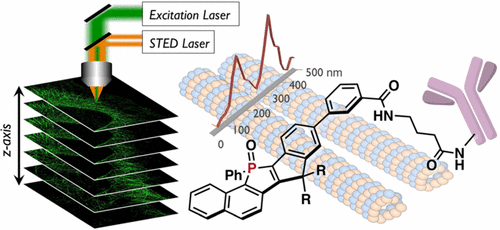当前位置:
X-MOL 学术
›
J. Am. Chem. Soc.
›
论文详情
Our official English website, www.x-mol.net, welcomes your
feedback! (Note: you will need to create a separate account there.)
Super-Photostable Phosphole-Based Dye for Multiple-Acquisition Stimulated Emission Depletion Imaging
Journal of the American Chemical Society ( IF 14.4 ) Pub Date : 2017-07-25 , DOI: 10.1021/jacs.7b04418 Chenguang Wang 1 , Masayasu Taki 1 , Yoshikatsu Sato 1 , Aiko Fukazawa 2 , Tetsuya Higashiyama 1, 3 , Shigehiro Yamaguchi 1, 2
Journal of the American Chemical Society ( IF 14.4 ) Pub Date : 2017-07-25 , DOI: 10.1021/jacs.7b04418 Chenguang Wang 1 , Masayasu Taki 1 , Yoshikatsu Sato 1 , Aiko Fukazawa 2 , Tetsuya Higashiyama 1, 3 , Shigehiro Yamaguchi 1, 2
Affiliation

|
As stimulated emission depletion (STED) microscopy can provide structural details of cells with an optical resolution beyond the diffraction limit, it has become an indispensable tool in cell biology. However, the intense STED laser beam usually causes rapid photobleaching of the employed fluorescent dyes, which significantly limits the utility of STED microscopy from a practical perspective. Herein we report a new design of super-photostable dye, PhoxBright 430 (PB430), comprising a fully ring-fused π-conjugated skeleton with an electron-accepting phosphole P-oxide unit. We previously developed a super-photostable dye C-Naphox by combining the phosphole unit with an electron-donating triphenylamine moiety. In PB430, removal of the amino group alters the transition type from intramolecular charge transfer character to π-π* transition character, which gives rise to intense fluorescence insensitive to molecular environment in terms of fluorescence colors and intensity, and bright fluorescence even in aqueous media. PB430 also furnishes high solubility in water, and is capable of labeling proteins with maintaining high fluorescence quantum yields. This dye exhibits outstanding resistance to photoirradiation even under the STED conditions and allows continuous acquisition of STED images. Indeed, using a PB430-conjugated antibody, we succeed in attaining a 3-D reconstruction of super-resolution STED images as well as photostability-based multicolor STED imaging of fluorescently labeled cytoskeletal structures.
中文翻译:

用于多采集受激发射损耗成像的超光稳定磷光体染料
由于受激发射损耗 (STED) 显微镜可以提供超出衍射极限的光学分辨率的细胞结构细节,它已成为细胞生物学中不可或缺的工具。然而,强烈的 STED 激光束通常会导致所用荧光染料的快速光漂白,这从实际角度显着限制了 STED 显微镜的实用性。在此,我们报告了一种新设计的超光稳定染料 PhoxBright 430 (PB430),它包含一个全环稠合的 π 共轭骨架和一个接受电子的磷磷 P-氧化物单元。我们之前通过将磷单元与供电子三苯胺部分结合,开发了一种超耐光染料 C-Naphox。在 PB430 中,氨基的去除将转变类型从分子内电荷转移特征改变为 π-π* 转变特征,这产生在荧光颜色和强度方面对分子环境不敏感的强烈荧光,甚至在水性介质中也产生明亮的荧光。PB430 还具有在水中的高溶解度,并且能够以保持高荧光量子产率标记蛋白质。这种染料即使在 STED 条件下也表现出出色的抗光辐射能力,并允许连续获取 STED 图像。事实上,使用 PB430 偶联抗体,我们成功实现了超分辨率 STED 图像的 3D 重建以及荧光标记细胞骨架结构的基于光稳定性的多色 STED 成像。PB430 还具有在水中的高溶解度,并且能够以保持高荧光量子产率标记蛋白质。这种染料即使在 STED 条件下也表现出出色的抗光辐射能力,并允许连续获取 STED 图像。事实上,使用 PB430 偶联抗体,我们成功实现了超分辨率 STED 图像的 3D 重建以及荧光标记细胞骨架结构的基于光稳定性的多色 STED 成像。PB430 还具有在水中的高溶解度,并且能够以保持高荧光量子产率标记蛋白质。这种染料即使在 STED 条件下也表现出出色的抗光辐射能力,并允许连续获取 STED 图像。事实上,使用 PB430 偶联抗体,我们成功实现了超分辨率 STED 图像的 3D 重建以及荧光标记细胞骨架结构的基于光稳定性的多色 STED 成像。
更新日期:2017-07-25
中文翻译:

用于多采集受激发射损耗成像的超光稳定磷光体染料
由于受激发射损耗 (STED) 显微镜可以提供超出衍射极限的光学分辨率的细胞结构细节,它已成为细胞生物学中不可或缺的工具。然而,强烈的 STED 激光束通常会导致所用荧光染料的快速光漂白,这从实际角度显着限制了 STED 显微镜的实用性。在此,我们报告了一种新设计的超光稳定染料 PhoxBright 430 (PB430),它包含一个全环稠合的 π 共轭骨架和一个接受电子的磷磷 P-氧化物单元。我们之前通过将磷单元与供电子三苯胺部分结合,开发了一种超耐光染料 C-Naphox。在 PB430 中,氨基的去除将转变类型从分子内电荷转移特征改变为 π-π* 转变特征,这产生在荧光颜色和强度方面对分子环境不敏感的强烈荧光,甚至在水性介质中也产生明亮的荧光。PB430 还具有在水中的高溶解度,并且能够以保持高荧光量子产率标记蛋白质。这种染料即使在 STED 条件下也表现出出色的抗光辐射能力,并允许连续获取 STED 图像。事实上,使用 PB430 偶联抗体,我们成功实现了超分辨率 STED 图像的 3D 重建以及荧光标记细胞骨架结构的基于光稳定性的多色 STED 成像。PB430 还具有在水中的高溶解度,并且能够以保持高荧光量子产率标记蛋白质。这种染料即使在 STED 条件下也表现出出色的抗光辐射能力,并允许连续获取 STED 图像。事实上,使用 PB430 偶联抗体,我们成功实现了超分辨率 STED 图像的 3D 重建以及荧光标记细胞骨架结构的基于光稳定性的多色 STED 成像。PB430 还具有在水中的高溶解度,并且能够以保持高荧光量子产率标记蛋白质。这种染料即使在 STED 条件下也表现出出色的抗光辐射能力,并允许连续获取 STED 图像。事实上,使用 PB430 偶联抗体,我们成功实现了超分辨率 STED 图像的 3D 重建以及荧光标记细胞骨架结构的基于光稳定性的多色 STED 成像。











































 京公网安备 11010802027423号
京公网安备 11010802027423号